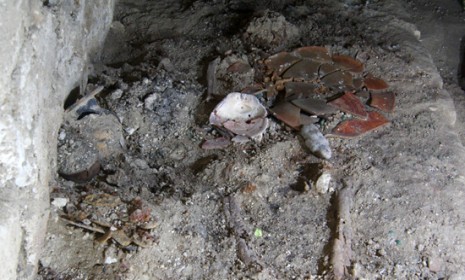'Lady Snake Lord': Inside the tomb of a Maya warrior queen
Researchers believe they've discovered the burial place of a powerful seventh-century Maya ruler

While excavating a royal Maya city in northwestern Guatemala, a team of researchers made a fascinating discovery: A burial chamber, believed to belong to one of the greatest queens of Classic Maya civilization, Lady K’abel. The tomb not only holds her supposed remains, but precious artifacts giving clues to her life. Here, a guide to the find:
First of all, who was Lady K’abel?
She was the military governor of the ancient Maya Wak kingdom, representing her family, the "Snake" dynasty, between A.D. 672 and 692. Considered the greatest ruler of the Late Classic Maya period, Lady K’abel reigned with her husband, K'inich Bahlam but, as the "Supreme Warrior," held even higher authority than her spouse. "People like Lady K'abel show there were examples of extraordinary women that were able to position themselves in powerful roles," Traci Ardren, associate professor of anthropology at the University of Miami and a Mayan archaeologist, tells The Telegraph.
The Week
Escape your echo chamber. Get the facts behind the news, plus analysis from multiple perspectives.

Sign up for The Week's Free Newsletters
From our morning news briefing to a weekly Good News Newsletter, get the best of The Week delivered directly to your inbox.
From our morning news briefing to a weekly Good News Newsletter, get the best of The Week delivered directly to your inbox.
What did researchers find in the tomb?
The key find is a small alabaster jar carved in the shape of a conch shell, from which the head and arms of an old woman protrude. Hieroglyphs on the back of the jar feature the name "Lady Snake Lord," as well as "Lady Water Lily Hand," both of which are thought to refer to Lady K'abel. Researchers also found ceramic vessels, jade jewelry, blades, and large stone carvings that mention the queen. The skeleton in the tomb is in poor condition, but the researchers say its facial features match those on ancient carvings of the revered queen.
So it probably belongs to her?
Experts are leaning that way. It's hard to identify who is buried in royal tombs "unless they literally write it on the wall or something," David Stuart, a professor of Mesoamerican art and writing at the University of Texas at Austin, tells National Geographic. It's possible the jar covered in hieroglyphs was passed down from the queen to another women buried in the tomb, but "for this find, I think there's a fair chance it's her," Stuart says.
A free daily email with the biggest news stories of the day – and the best features from TheWeek.com
Sources: Smithsonian, The Telegraph, National Geographic


